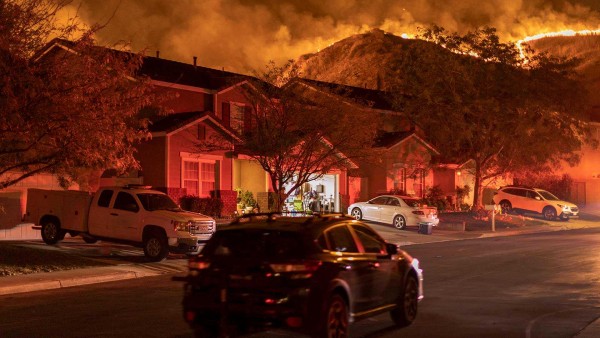UMD to Lead National Study of Wildfire Impacts on Infants
Past research on the health consequences of U.S. wildfires revealed how the increasingly widespread events damage the lungs, hearts and mental health of adults and children, but mostly ignored how resulting pollution and stress affect the earliest—and most vulnerable—stage of life.
Now, supported by a $2.9 million grant from the National Institutes of Health, researchers at the University of Maryland will conduct a large national study of the impacts of wildfires on infant health, from pregnancy through a child’s first year.
Led by health policy and management Associate Professor Michel Boudreaux, the study team will use data from birth and hospital records, atmospheric modeling, satellite imagery and more to examine the relationship between wildfire characteristics and birth, health and mortality data across different demographic, regional and socioeconomic groups.
“It’s a critical period of human development and infants are just more susceptible to these kinds of events,” said Boudreaux. “Exposures in utero show up at birth, like pre-term births, but the health effects really last throughout your life.”
The five-year study’s interdisciplinary research team includes epidemiology and biostatistics Professor and Chair Amir Sapkota, applied environmental health Professor Robin Puett, geographical sciences Associate Research Professor Evan Ellicott, atmospheric and oceanic science Professor Xin-Zhong Liang and atmospheric and oceanic science Assistant Research Professor Hao He as well as clinical partners from the Children’s Hospital of Philadelphia.
The United States averages about 70,000 wildfire events annually. Longer summers, droughts, extreme heat and strong winds triggered by climate change have fueled a significant increase in the destructiveness and size of wildfires, a pattern that a 2022 United Nations report said could increase 50% by the end of the century. According to the Environmental Protection Agency, wildfire patterns over the past 20 years have coincided with the warmest years on record.
Wildfire smoke now comprises between 25-40% of all fine particulate matter (or PM 2.5) air pollution, overtaking previous offenders like power plants and automobiles; there is now evidence that increased wildfire activity is rolling back air quality gains made over the past 50 years from policies like the Clean Air Act.
“It has become increasingly apparent that climate change is the largest threat to public health that we’re going to face,” said Boudreaux.
While fire events are often regional, their impacts are widespread; smoke plumes laden with PM 2.5 can travel thousands of miles. Like lead, there is no safe level of fine particulates, said Boudreaux. It travels deep into the lungs and has been linked to asthma and heart disease, as well as cognitive issues like decreased academic test scores and dementia in the elderly. Infants and fetuses are especially susceptible to toxic insults, said Boudreaux, which can cross the placental barrier; yet there have been a handful of regional studies on fetal health effects. The nationwide UMD study will include around 65 million infants over a 16-year period and robust exposure measurements, including residential proximity, smoke plume opacity and elevation, and concentrations of air pollutants.
“We will study how exposure to wildfire smoke in the first, second or third trimester impacts health outcomes at birth and use of health care resources in the first year of life,” he said.
The team will also examine how wildfire exposure varies across demographic groups and if some groups are more or less likely to be harmed by exposure when it occurs. Air pollution has traditionally been the worst in marginalized communities, but wildfire smoke tends to be a bigger problem for more affluent groups. However, not all communities have the same access to mitigation strategies like air filters and the ability to relocate during a smoke event.
“We might expect that people with lower socioeconomic status will respond differently, and worse, to wildfire exposure than higher socioeconomic groups, and that’s something we need to know so we can develop appropriate policy responses,” said Boudreaux.
Boudreaux hopes the study raises awareness to an emerging public health problem and that the team’s work spurs development of practical policy responses. Tourists walking through downtown Washington, D.C. last week might not have known that the haze obscuring their view across the Potomac River was actually residual smoke from wildfires in South Carolina. It’s an issue that impacts all people, says Boudreaux, regardless of geography.
“We’re now in a situation where we need to think about how we’re going to face this new threat,” he said. “We can no longer say, ‘This is happening in the future.’ This is happening right now.”
By Maggie Haslam
This story originally appeared in Maryland Today.
Photo: Flames menace a Chino, Calif., neighborhood during the Blue Ridge Fire in October 2020. By David McNew/Getty Images
Published on Wed, 04/19/2023 - 09:55


